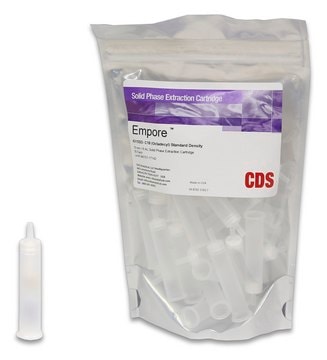66883-U
Empore™ SPE Disks
C18, diam. 47 mm, pk of 20
Synonyme(s) :
C18, SPE disk, 47 mm
About This Item
Produits recommandés
product name
Empore™ SPE Disks, matrix active group C18, diam. 47 mm, pk of 20
Description
C18
Gamme de produits
Empore™
Conditionnement
pk of 20
Fabricant/nom de marque
CDS Analytical 98-0604-0217-3
Technique(s)
solid phase extraction (SPE): suitable
Diamètre
47 mm
Épaisseur de la membrane
0.5 mm
Groupe de la matrice active
C18
Taille des particules
12 μm
Vous recherchez des produits similaires ? Visite Guide de comparaison des produits
Catégories apparentées
Description générale
The Empore line of SPE disks comprises of the most complete line of SPE disks for extracting large volumes of aqueous samples. The product line ranges from time-tested C18 to unique phase chemistries such as carbon and the highly polar Oil & Grease disk. The disks are ideal for environmental analysis where 1 L sample volumes are not uncommon and provide an efficient alternative to LLE.
Save Time & Money:
- Reduced SPE Bed Mass = Reduced SPE Solvent & Elution Volumes
- Minimize SPE eluate evaporation time
- Potentially allows for direct injection of the SPE eluate
- Dense & Uniform Extraction Medium = No SPE Channeling and Voiding
- Efficient mass-transfer kinetics allow for faster flow rates
- Eliminate SPE fines improving column and instrument life
Application
- EPA Method 506 - Phthlate & Adipate Esters
- EPA Method 508.1 - Chlorinated Pesticides, Herbicides and Organohalides
- EPA Method 525.2 - Semi-Volatile Organic Compounds
- EPA Method 532 - Phenylurea Pesticides
- EPA Method 550.1 - PAHs
- EPA Method 553 - Benzidines and Nitrogen-Containing Pesticides
- EPA Method 554 - Carbonyl Compounds
- EPA Method 555 - Chlorinated Acids
- 608ATP3M0222 - Organochlorine Pesticides and PCBs
- 1613B - Dioxins and Furans
- 3535 - Organichlorine Pesticides & Phthalate Esters
- 8330A - Nitroaromatics & Nitroamines
- 8095 - Explosives
- 8323 - Organotins
- 8321b - Solvent extractable non-volatile compounds
- Dioxin DLM01.1 - Octo-chlorinated Dibenzo-p-dioxins (CDDs) and Dibenzofurans (CDFs)
Informations légales
Clause de non-responsabilité
Code de la classe de stockage
11 - Combustible Solids
Classe de danger pour l'eau (WGK)
WGK 3
Point d'éclair (°F)
Not applicable
Point d'éclair (°C)
Not applicable
Choose from one of the most recent versions:
Certificats d'analyse (COA)
Sorry, we don't have COAs for this product available online at this time.
If you need assistance, please contact Service Clients
Déjà en possession de ce produit ?
Retrouvez la documentation relative aux produits que vous avez récemment achetés dans la Bibliothèque de documents.
Les clients ont également consulté
Notre équipe de scientifiques dispose d'une expérience dans tous les secteurs de la recherche, notamment en sciences de la vie, science des matériaux, synthèse chimique, chromatographie, analyse et dans de nombreux autres domaines..
Contacter notre Service technique









